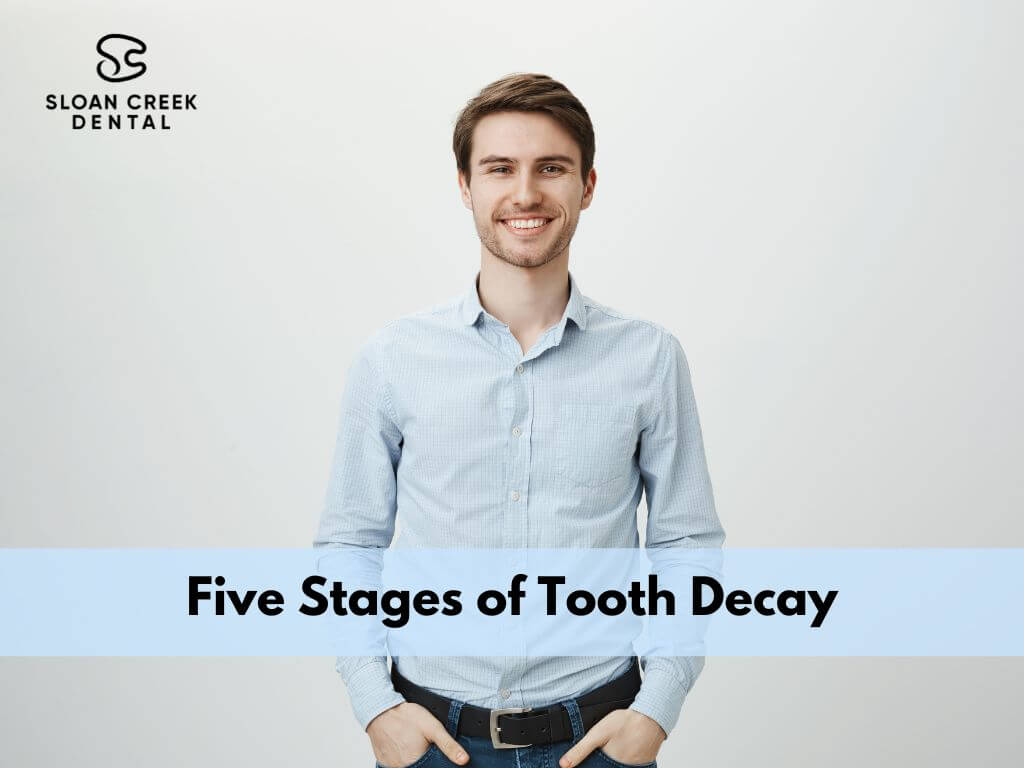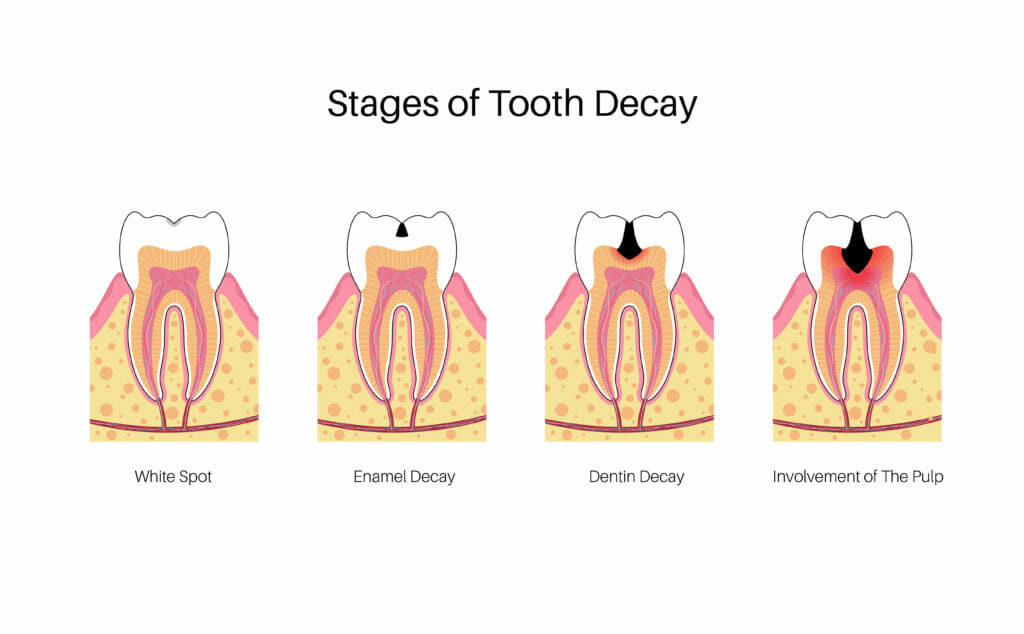
Tooth decay doesn’t just happen because you ate a piece of candy or drank soda once. It happens because bacteria in your mouth produce acids that wear away at your teeth until they form holes and cavities.
If you’re looking for ways to prevent tooth decay or treat it before it gets too bad, understanding the stages of tooth decay can help you take charge of your oral health—especially the early stages!
Tooth decay is a problem that can result in cavities (dental caries), dental abscesses, and even tooth loss. It happens when certain species of bacteria that live in dental plaque break down the sugars in your diet into acids. Plaque is a sticky, colorless film that forms on your teeth. If plaque is not removed from your teeth regularly, acids will begin to eat away at the enamel.
There are several stages of tooth decay, and treatment of tooth decay varies by stage. Here are some common symptoms of tooth decay.


Steps you can take to prevent plaque build-up and decay include:
The first stage of tooth decay is initial demineralization. This happens when your tooth’s protective outer layer, called enamel, is worn away by acidic foods and beverages or bacteria. Enamel is made up of microscopic crystals, which are made from minerals like calcium and phosphate. Your body uses these minerals to build your bones, but they also help protect the inner parts of your teeth from dental decay. If you have weak enamel or if your teeth have been exposed to too much acid, you’re more likely to experience this early stage of tooth decay. When a white spot appears on a tooth, it can mean that that’s an indication of tooth decay.
Suppose you want to stop the process of tooth-enamel demineralization. In that case, you should consider dental sealants and or fluoride in your oral hygiene regimen (fluoride treatment or fluoride toothpaste). Saliva produced from chewing sugar-free gum is also beneficial to protecting your tooth enamel.
Enamel is the protective outer layer of your tooth, and it’s made up of a combination of minerals, including calcium, phosphorus, and fluoride. When you have enamel decay, your teeth can become very sensitive to temperature changes, and you may experience pain when eating or drinking hot or cold foods. Teeth that are affected by enamel decay are more likely to develop cavities.
To prevent enamel decay, using fluoride toothpaste, brushing, flossing, and rinsing with an antiseptic mouthwash every day can help prevent enamel loss from occurring. Visiting your dentist every six months for regular checkups and teeth cleaning is an excellent way to be proactive in your dental health.

The third stage of the tooth decay process is dentin decay. Dentine is the layer of your teeth that lies below the enamel and between the pulp. Because of its softness, dentin is more susceptible to damage from acid than enamel. This means that dental decay can progress more quickly once it reaches the dentin.
When tooth decay affects the dentin, which contains tubules (small hollow tubes or canals) that lead to the tooth’s nerves, you can experience sensitivity. This may be especially pronounced when eating hot or cold foods or drinks.
If you detect early signs of tooth decay, a filling can be used to address the problem. However, if damage has spread through the entire tooth structure and pulp, your dentist will likely remove the decayed area of your tooth and cover the remaining tooth structure with a crown.
Your tooth’s pulp is the soft inner part that contains nerves, blood vessels, and connective tissue. The nerves help keep your tooth healthy and alert you to changes in temperature or pressure inside your mouth.
When the pulp in your tooth becomes damaged and irritated, it may start to swell, and because the surrounding area cannot expand to ease the swelling, it can cause pain and sensitivity to heat and cold.
When tooth decay reaches the pulp, a root canal treatment will likely be needed. A patient can be treated by their general dentist, or in severe cases; they may be referred to an endodontist, a specialist in this type of procedure.
If tooth decay continues progressing and reaches the pulp, an infection can develop that affects the nerves, blood vessels, and jawbone. The infection can spread to other teeth or form a pocket of pus called an abscess.
Tooth abscesses are painful, and they can cause swelling in your gums, face, or jaw. You may also have a fever and swollen lymph nodes in your neck. If you have a tooth abscess, it is important to receive prompt treatment to avoid losing the tooth. If left untreated, the infection can spread to your jawbone, and sometimes the infected tooth may need to be extracted.

Did you know tooth decay can start in the early stages without symptoms? That’s why it’s so important to visit your dentist regularly. Your dentist can identify and address early signs of tooth decay before they worsen, which will help keep your teeth healthy for a long time! If you experience tooth sensitivity, tooth pain, or swelling in or around your mouth, make an appointment with your dentist. These are all signs of the later stages of tooth decay or another dental condition that needs attention.
Dental caries, or cavities, can be caused by a variety of factors. The most common include:
Yes, they are. Tooth decay is the most common disease in children ages 2-5 years old. To help prevent tooth decay, knowing how to prevent it and what to do if you think your child has it is important.
How do I know if my child has tooth decay?
Tooth decay can cause pain and swelling of the gums, making eating uncomfortable. You may notice that your child is drooling more than usual or being more fussy while eating than usual. If this happens, take them to a dentist as soon as possible.
What should I do if my child has tooth decay?
If your child has tooth decay, they need to see a dentist right away! The sooner you get them in to see a dentist, the easier it will be for them to treat the problem and stop it from getting worse. They’ll need to have an X-ray taken so they can see what’s going on inside their mouth, and then they’ll be able to tell you exactly how things are before making any decisions about treatment options.
It depends on the tooth and how badly it’s been damaged. In most cases, tooth decay can take anywhere from a few weeks to several months. The longer you wait to get treatment, the worse the damage will be and the more expensive it will be to fix.
Dentists fix decaying teeth by removing the decayed portion of the tooth and then placing a filling in the area. If extensive decay or weakened teeth are an issue, you may need a crown to restore the tooth.
Your oral health is the foundation of your overall health. With a good daily dental hygiene routine, regular visits to your dentist, and the right information about what you can do to keep your teeth for life, you can ensure that you’ll have healthy teeth and gums for years. But oral hygiene can often be overlooked, and it’s important for you to know exactly how important it is. As your local family dentist near the Allen and Fairview area, we are here to help you with any questions or concerns that you might have about keeping your smile healthy.
If you need any dental treatment and would like to reduce yoru risk of tooth decay, our team is here to answer all of your treatment option questions to find the right dental solution for healthy teeth. To schedule your appointment, contact Sloan Creek Dental, and our friendly staff will be happy to assist you. You can reach us at our Fairview, TX dental office to schedule an in-person consultation with us today – 972-468-1440.
Our dental office is located in Fairview, Texas, and our patients visit us from across the surrounding areas, including Allen, Plano, McKinney, and Lucas.
We firmly believe that the internet should be available and accessible to anyone, and are committed to providing a website that is accessible to the widest possible audience, regardless of circumstance and ability.
To fulfill this, we aim to adhere as strictly as possible to the World Wide Web Consortium’s (W3C) Web Content Accessibility Guidelines 2.1 (WCAG 2.1) at the AA level. These guidelines explain how to make web content accessible to people with a wide array of disabilities. Complying with those guidelines helps us ensure that the website is accessible to all people: blind people, people with motor impairments, visual impairment, cognitive disabilities, and more.
This website utilizes various technologies that are meant to make it as accessible as possible at all times. We utilize an accessibility interface that allows persons with specific disabilities to adjust the website’s UI (user interface) and design it to their personal needs.
Additionally, the website utilizes an AI-based application that runs in the background and optimizes its accessibility level constantly. This application remediates the website’s HTML, adapts Its functionality and behavior for screen-readers used by the blind users, and for keyboard functions used by individuals with motor impairments.
If you’ve found a malfunction or have ideas for improvement, we’ll be happy to hear from you. You can reach out to the website’s operators by using the following email
Our website implements the ARIA attributes (Accessible Rich Internet Applications) technique, alongside various different behavioral changes, to ensure blind users visiting with screen-readers are able to read, comprehend, and enjoy the website’s functions. As soon as a user with a screen-reader enters your site, they immediately receive a prompt to enter the Screen-Reader Profile so they can browse and operate your site effectively. Here’s how our website covers some of the most important screen-reader requirements, alongside console screenshots of code examples:
Screen-reader optimization: we run a background process that learns the website’s components from top to bottom, to ensure ongoing compliance even when updating the website. In this process, we provide screen-readers with meaningful data using the ARIA set of attributes. For example, we provide accurate form labels; descriptions for actionable icons (social media icons, search icons, cart icons, etc.); validation guidance for form inputs; element roles such as buttons, menus, modal dialogues (popups), and others. Additionally, the background process scans all of the website’s images and provides an accurate and meaningful image-object-recognition-based description as an ALT (alternate text) tag for images that are not described. It will also extract texts that are embedded within the image, using an OCR (optical character recognition) technology. To turn on screen-reader adjustments at any time, users need only to press the Alt+1 keyboard combination. Screen-reader users also get automatic announcements to turn the Screen-reader mode on as soon as they enter the website.
These adjustments are compatible with all popular screen readers, including JAWS and NVDA.
Keyboard navigation optimization: The background process also adjusts the website’s HTML, and adds various behaviors using JavaScript code to make the website operable by the keyboard. This includes the ability to navigate the website using the Tab and Shift+Tab keys, operate dropdowns with the arrow keys, close them with Esc, trigger buttons and links using the Enter key, navigate between radio and checkbox elements using the arrow keys, and fill them in with the Spacebar or Enter key.Additionally, keyboard users will find quick-navigation and content-skip menus, available at any time by clicking Alt+1, or as the first elements of the site while navigating with the keyboard. The background process also handles triggered popups by moving the keyboard focus towards them as soon as they appear, and not allow the focus drift outside of it.
Users can also use shortcuts such as “M” (menus), “H” (headings), “F” (forms), “B” (buttons), and “G” (graphics) to jump to specific elements.
We aim to support the widest array of browsers and assistive technologies as possible, so our users can choose the best fitting tools for them, with as few limitations as possible. Therefore, we have worked very hard to be able to support all major systems that comprise over 95% of the user market share including Google Chrome, Mozilla Firefox, Apple Safari, Opera and Microsoft Edge, JAWS and NVDA (screen readers), both for Windows and for MAC users.
Despite our very best efforts to allow anybody to adjust the website to their needs, there may still be pages or sections that are not fully accessible, are in the process of becoming accessible, or are lacking an adequate technological solution to make them accessible. Still, we are continually improving our accessibility, adding, updating and improving its options and features, and developing and adopting new technologies. All this is meant to reach the optimal level of accessibility, following technological advancements. For any assistance, please reach out to